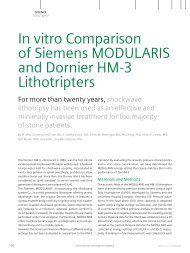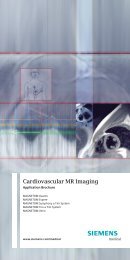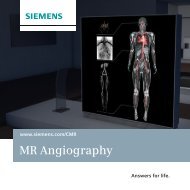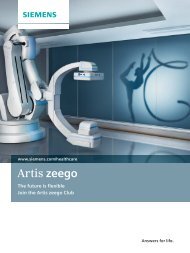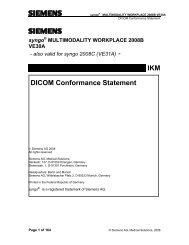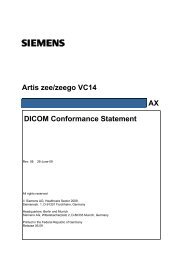SOMATOM Sessions - Siemens Healthcare
SOMATOM Sessions - Siemens Healthcare
SOMATOM Sessions - Siemens Healthcare
You also want an ePaper? Increase the reach of your titles
YUMPU automatically turns print PDFs into web optimized ePapers that Google loves.
Clinical Results Cardio-Vascular<br />
Case 4<br />
Pre-operative Exclusion of Coronary<br />
Artery Stenosis With Less Than 1 mSv Dose<br />
By Sebastian Leschka, MD* and Andreas Blaha**<br />
* Institute of Diagnostic Radiology, University Hospital Zurich, Zurich, Switzerland<br />
**<br />
Business Unit CT, <strong>Siemens</strong> <strong>Healthcare</strong>, Forchheim, Germany<br />
HISTORY<br />
A 71-year-old male patient with a history<br />
of cerebral infarction caused by a highgrade<br />
stenosis of the left internal carotid<br />
artery and lysis therapy was now referred<br />
to the radiology department to<br />
rule out coronary artery disease.<br />
In addition to the coronary CT Angiography<br />
(CTA) examination a non-enhanced<br />
calcium-scoring scan (CaSc)<br />
was performed.<br />
The CTA was acquired with a fast pitch<br />
spiral technique (Flash Spiral Cardio)<br />
while a mean heart rate of 56 bpm was<br />
present.<br />
DIAGNOSIS<br />
Threshold = 130 HU (102.7 mg/cm 3 CaHA)<br />
In total, ten calcified lesions could be<br />
detected in the CaSc. Diffuse distribution<br />
of calcified deposits was observed in<br />
the right coronary artery (RCA), the left<br />
artery descending (LAD) and the left circumflex<br />
coronary artery (CX). The total<br />
Agatston score was 130.<br />
CTA unveiled a normal coronary artery<br />
anatomy, right dominant coronary supply<br />
type with regular sized lumen of the<br />
coronary arteries. RCA and LAD showed<br />
no hemodynamic relevant lesions. CX<br />
coronary artery unveiled a stenosis<br />
smaller than 50% in its proximal segment.<br />
A deep myocardial bridging of the<br />
LAD could also be depicted.<br />
38 <strong>SOMATOM</strong> <strong>Sessions</strong> · May 2010 · www.siemens.com/healthcare-magazine<br />
COMMENTS<br />
In combination with the CaSc (0.35 mSv)<br />
and the CTA (0.8 mSv), an effective<br />
dose* of 1.1 mSv was applied to the<br />
patient to detect coronary artery disease.<br />
The entire acquisition time of the CTA<br />
was 280 ms; calcium scoring was<br />
acquired in 120 ms.<br />
The Flash Spiral cardio method quickly<br />
and reliably combines low radiation<br />
dose values with the accurate display of<br />
the coronary arteries in all segments.<br />
Artery Numbers of Calcium Score (2) Volume [mm 3 ] (3) Equiv. Mass<br />
Lesions (1) [mg CaHA] (4)<br />
LM 0 0.0 0.00 0.0<br />
LAD 2 27.5 29.3 4.89<br />
CX 3 48.3 50.5 8.57<br />
RCA 5 53.6 66.2 10.81<br />
Total 10 129.5 146.0 24.27<br />
(1) Lesion is volume based, (2) Equivalent Agatston score, (3) Isotropic interpolated volume, (4) Calibration Factor: 0.790<br />
*Effective Dose was calculated using the published conversion factor for an adult chest of 0.014 mSv (mGy cm) -1 [1].<br />
[1] McCollough CH et al. Strategies for Reducing Radiation Dose in CT, Radiol. Clin. N. Am. 47: (2009) 27-40.


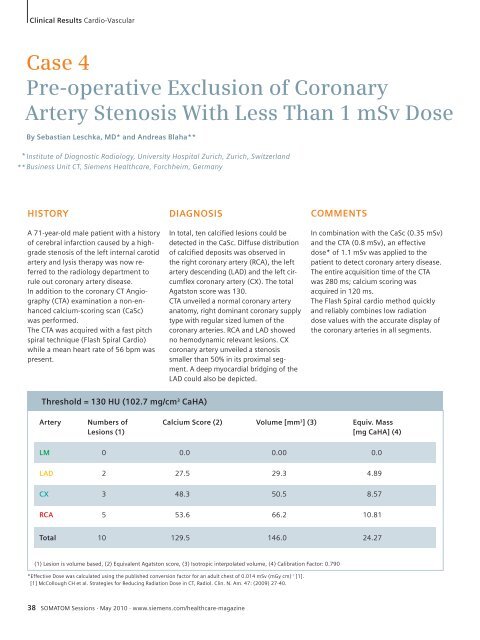

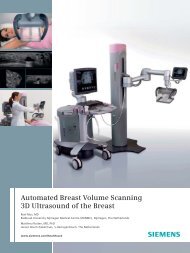
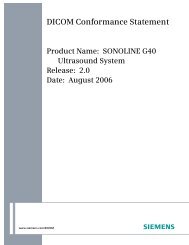
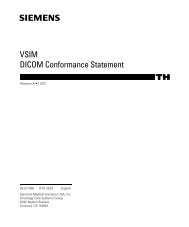

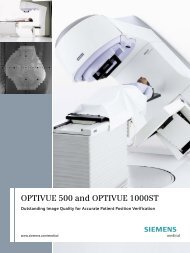
![WalkAway plus Technical Specifications [41 KB] - Siemens Healthcare](https://img.yumpu.com/51018135/1/190x253/walkaway-plus-technical-specifications-41-kb-siemens-healthcare.jpg?quality=85)
